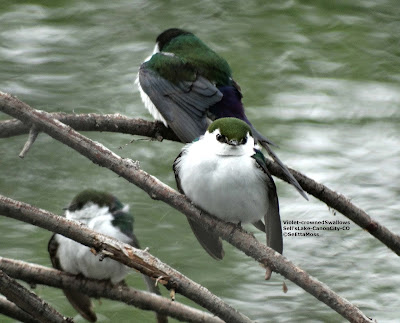Male Dickcissel keeping company with female Dickcissel
So as I watched the Dickcissels flying frequently around the hayfield yesterday it seemed that something was clearly different from previous days with less flying activity. One obvious difference was my observing female Dickcissels on 3 separate occasions yesterday when I had not seen any females on previous days. Each time I observed a female she was in close proximity (usually with a foot or two) to a male Dickcissel.
These two not-so-good pics show one of the occasions when I observed a female Dickcissel and with a male perched close by. Interestingly Birds of North America (BNA) online discusses how males behaves around females as follows: "Male begins almost continuous singing as soon as he is on territory, and when a female settles on his territory, he spends most of his time accompanying her as she forages and inspects nest sites. This close attentiveness persists through nest-building, egg-laying, and incubation, but wanes rapidly after hatching. " [Temple, Stanley A. 2002. Dickcissel (Spiza americana), http://bna.birds.cornell.edu/bna/species/703]
So it seems plausible that the difference I observed was because the females had just arrived and the males were, like the ones I observed with the females, engaged in accompanying them flying around the field as she 'forages and inspects nest sites.' Note today I was not able to get out to watch them until later this evening so add any additional observations at this time. I do hope the females pick sites near the fence or other locations that will not be mowed as there is no way they will have time to nest before this field is cut down. SeEtta
These two not-so-good pics show one of the occasions when I observed a female Dickcissel and with a male perched close by. Interestingly Birds of North America (BNA) online discusses how males behaves around females as follows: "Male begins almost continuous singing as soon as he is on territory, and when a female settles on his territory, he spends most of his time accompanying her as she forages and inspects nest sites. This close attentiveness persists through nest-building, egg-laying, and incubation, but wanes rapidly after hatching. " [Temple, Stanley A. 2002. Dickcissel (Spiza americana), http://bna.birds.cornell.edu/bna/species/703]
So it seems plausible that the difference I observed was because the females had just arrived and the males were, like the ones I observed with the females, engaged in accompanying them flying around the field as she 'forages and inspects nest sites.' Note today I was not able to get out to watch them until later this evening so add any additional observations at this time. I do hope the females pick sites near the fence or other locations that will not be mowed as there is no way they will have time to nest before this field is cut down. SeEtta





Comments